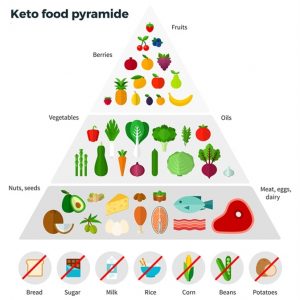If you have been diagnosed with diabetes, you may be familiar with ketoacidosis – but you may not understand the full extent of what is happening inside your body. Ketoacidosis is a potentially deadly situation, as it can cause severe medical emergencies and even death if not treated correctly. This article will break down the basics of ketoacidosis, from its root causes to warning signs and symptoms. With the knowledge gained from this article, you will be able to recognize the signs of ketoacidosis and take the necessary action to protect your health.
Table of Contents
- 1. “The Peril of Ketoacidosis – When a Deadly Situation is Unavoidable”
- 2. “A Closer Look at Ketoacidosis – What Causes This Potentially Life-Threatening Condition”
- 3. “Living with Ketoacidosis – Sustaining a Safe Quality of Life”
- 4. “Preventing Ketoacidosis – An Ounce of Prevention is Worth a Pound of Cure”
- 5. “Living with Ketoacidosis – Finding the Right Resources to Stay Safe
- Q&A

1. “The Peril of Ketoacidosis – When a Deadly Situation is Unavoidable”
The Danger
Ketoacidosis is a life-threatening condition that can arise in people with diabetes, especially during episodes of dangerously high or low blood sugar levels. It is caused by an excessive amount of acid in the bloodstream due to the body’s inability to use glucose for energy. The symptoms of ketoacidosis include rapid breathing, excessive thirst, confusion, fatigue, excessive urination, nausea, and vomiting.
Prevention is Key
The good news is that through routine glucose monitoring and conscientious management of diabetes, ketoacidosis can usually be prevented. Here are some tips to get started:
- Monitor and consistently log your blood sugar
- Take insulin as prescribed
- Drink plenty of water
- Eat meals at regular times
- Reduce alcohol consumption
- Recognize and address symptoms of low blood sugar
By following these tips, you can drastically reduce the risk of developing ketoacidosis. If symptoms of ketoacidosis present, contact your health care provider or nearest emergency room immediately.
2. “A Closer Look at Ketoacidosis – What Causes This Potentially Life-Threatening Condition”
Ketoacidosis is a life-threatening condition defined by the accumulation of ketone acids in the body. The two primary types of ketoacidosis are diabetic ketoacidosis (DKA) and alcoholic ketoacidosis (AKA) which are caused by completely different situations.
What is the cause of DKA?
Diabetic ketoacidosis is caused by a lack of the hormone insulin or an increase in resistance to the hormone insulin. This occurs when a person with diabetes fails to properly manage their insulin levels, resulting in high glucose levels. When the body is unable to metabolize glucose easily, it begins to break down stored fat, which creates ketone acids.
What is the cause of AKA?
Alcoholic ketoacidosis (AKA) is caused by excessive alcohol consumption. Alcohol is metabolized differently than other nutrients and forces the body to break down fats and proteins for energy. This process creates ketone acids which can build up in the bloodstream and lead to AKA.
The symptoms of AKA are similar to those of DKA, which can further complicate diagnosis. It’s important to seek medical care immediately if you experience any of the following signs:
- Frequent urination
- Excessive thirst
- Extreme hunger
- Rapid breathing
- Confusion
It is difficult to diagnose AKA without a blood or urine test, so it is important to seek medical attention immediately if you are experiencing any of the above symptoms after consuming large amounts of alcohol. Untreated ketoacidosis can result in coma, kidney failure, and death.
3. “Living with Ketoacidosis – Sustaining a Safe Quality of Life”
Living with ketoacidosis can be an ongoing challenge. If you or a loved one has been diagnosed with ketoacidosis, there are ways to help manage the condition, and allow for a safer, more comfortable quality of life.
It is recommended to monitor your blood sugar regularly. Use a glucose monitor and record readings at least three times a day, or as prescribed by a health care provider. It is also important to test your urine for ketones whenever your blood sugar is higher than 240 milligrams per deciliter. Furthermore, it is best to avoid alcohol and moderate or limit caffeine. For meals, plan out and enjoy healthy, balanced meals while avoiding foods high in sugar and carbohydrates.
- Monitor your blood sugar regularly.
- Test urine for ketones when blood sugar is higher than 240 milligrams per deciliter.
- Avoid alcohol and moderate or limit caffeine.
- Plan and enjoy healthy, balanced meals.
- Avoid foods high in sugar and carbohydrates.
4. “Preventing Ketoacidosis – An Ounce of Prevention is Worth a Pound of Cure”
Ketoacidosis is a serious and potentially dangerous side effect of diabetes, both type 1 and type 2. But the good news is that, with awareness and good diabetes management, it can be prevented. Here are four steps to lower your risk of developing ketoacidosis:
- Monitor Blood Glucose Levels: Regularly monitor your blood glucose levels and keep them within the target range. If you notice an out of range reading, take immediate steps to fix it.
- Eat a Balanced Diet: Incorporate healthy fats and proteins from plant and animal sources, and include plenty of veggies and whole grains into your meals. Stay away from refined and sugary foods.
- Stay Active: Exercise regularly to help keep your blood sugar levels in check. Even a small amount of activity, such as a 30 minute walk every day, can make a difference.
- Follow Your Medication Schedule: Take your medication and insulin as instructed and on time. Check-in with your healthcare provider regularly to adjust your dose, if needed.
With these steps, you can keep your diabetes in check and lower the risk of ketoacidosis. However, if you do experience symptoms of ketoacidosis, contact your healthcare provider right away. It’s best to detect and treat the condition early to avoid further health complications.
5. “Living with Ketoacidosis – Finding the Right Resources to Stay Safe
Living with ketoacidosis can be difficult, but it is not impossible. With the right resources, ketoacidosis can not only be managed but it can also be prevented. Here are the top five resources to living safely with ketoacidosis:
- Health Care Team: Reaching out to an experienced team of health care providers, including doctors, nurses, and dietitians, can provide you with the best advice for managing and preventing ketoacidosis.
- Ketoacidosis Trackers: Keeping a record of your vital signs and symptoms can help alert you to potentially dangerous ketoacidosis activity. There are now apps available to make tracking easy and accessible.
- Educational Materials: A variety of books, websites, videos, and even online support groups provide you with useful information about ketoacidosis.
- Ketoacidosis Monitoring Devices: Such as a glucometer or ketone meters can provide you with accurate readings.
- Exercise: Moderate exercise can help improve blood glucose levels and reduce the risk of ketoacidosis.
By understanding the resources that are available, you can ensure that you are well-equipped to manage and prevent ketoacidosis. With the correct information and resources, living with ketoacidosis does not have to be a burden. It can be manageable and ensure a healthy, safe life.
It’s quite clear that ketoacidosis is something that should not be taken lightly. If you even suspect that you may have ketoacidosis, it is important to act as soon as possible and seek medical attention. Stay informed and stay safe.











